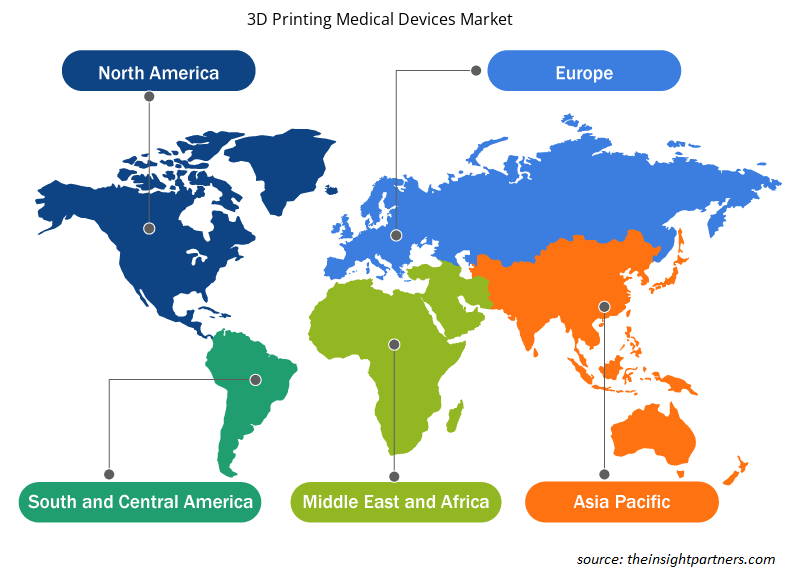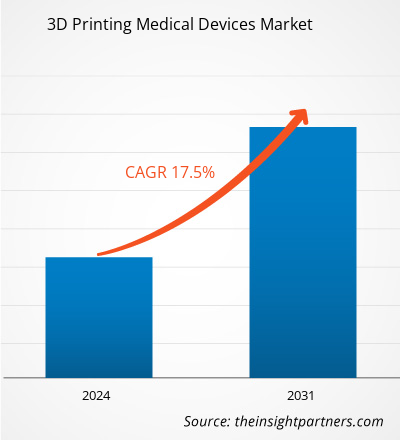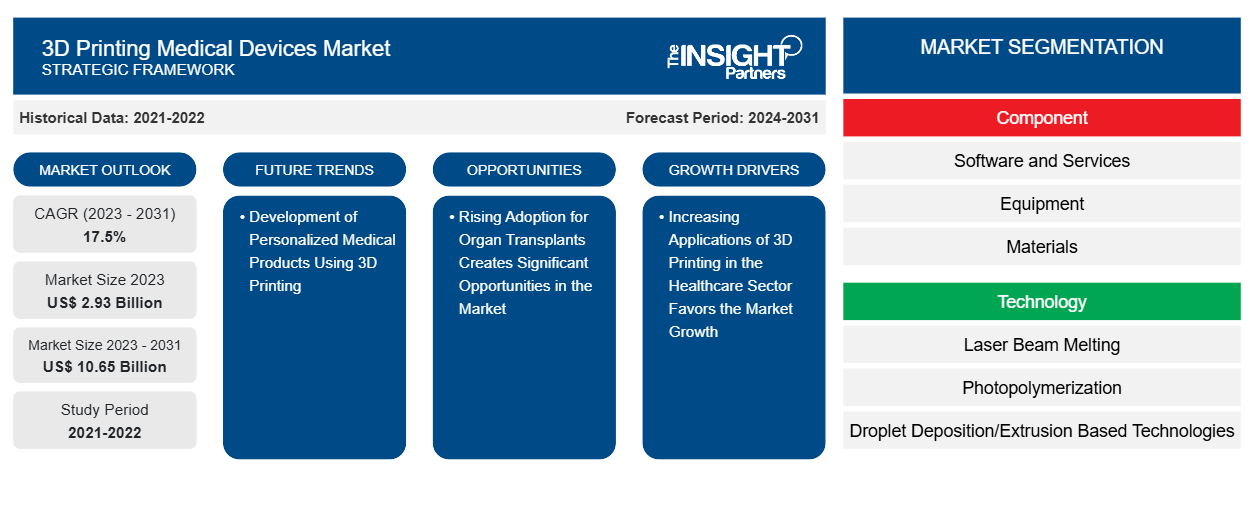3D プリント医療機器の市場規模は、2023 年の 29.3 億米ドルから 2031 年には 106.5 億米ドルに達すると予測されています。市場は 2023 年から 2031 年にかけて 17.5% の CAGR を記録すると予想されています。3D プリントを使用したパーソナライズされた医療製品の開発は、今後も市場の主要なトレンドであり続けると思われます。
3Dプリント医療機器市場分析
3D プリントで作られた医療機器の市場は確立されています。医療分野での 3D プリントの使用の増加は、採用を促進し、市場全体の拡大に貢献しています。臓器移植手術の増加により、3D プリント医療機器の需要が高まっています。このような強化要素は、市場全体の拡大に影響します。まもなく、3D プリントによるカスタマイズされた医療製品の作成は、市場拡大の有益な見通しをもたらすでしょう。
3Dプリント医療機器市場の概要
近年、インプラント医療機器では、その精度と最適な材料利用能力により、3D 印刷技術の使用が増加しています。外傷学、整形外科、歯科の分野は、これらの機器から最大の恩恵を受けるでしょう。3D 印刷技術を使用すれば、どんなに複雑な形状のインプラント医療機器でも、処理上の問題が発生することなく製造できます。複雑なインプラント医療機器の作成と製造に関する問題を解決できます。パーソナライズされカスタマイズされたインプラント医療機器も、3D 印刷プロセスを使用して作成できます。
世界で 2 番目に多い歯科疾患は虫歯です。性別によってわずかな違いはあるものの、歯列矯正の問題は男女ともに一般的です。カスタマイズ製品の潜在性により、医療および歯科用途の 3D 印刷の進歩、小規模生産のコスト削減、患者の画像データの共有と処理の容易さ、教育の改善が促進されています。歯周病学と歯内療法学の専門分野における用途に関する出版物は限られています。3D 印刷技術は主に口腔外科と補綴学の用途に重点が置かれており、次に歯列矯正学が続きます。3D 印刷技術の臨床使用により、外科医は高度な画像処理を使用してリアルな物理的解剖モデルで手術を行うことができます。
要件に合わせてレポートをカスタマイズする
このレポートの一部、国レベルの分析、Excelデータパックなど、あらゆるレポートを無料でカスタマイズできます。また、スタートアップや大学向けのお得なオファーや割引もご利用いただけます。
-
このレポートの主要な市場動向を入手してください。この無料サンプルには、市場動向から見積もりや予測に至るまでのデータ分析が含まれます。
3Dプリント医療機器市場の推進要因と機会
ヘルスケア分野での 3D プリントの応用の増加が市場の成長を後押しします。
3D プリンターを使用して、患者の特定の解剖学的構造に対応する複雑な形状や機能を備えたさまざまな医療機器が製造されています。標準設計では、いくつかの機器が印刷され、その後、同じ機器の多数のレプリカが作成されます。患者固有の画像データを使用して、患者対応機器または患者固有の機器とも呼ばれる追加の機器が開発されます。印刷物の用途とプリンターの使いやすさは、3D 印刷技術を選択する際の 2 つの考慮事項です。医療機器の 3D 印刷で最も人気のある技術は、パウダー ベッド フュージョンです。この方法は、医療機器で使用されるナイロンやチタンなどのさまざまな材料で機能します。CT スキャンと MRI スキャンを使用して、3D 印刷により、各患者に固有の触覚参照モデルを安価かつ簡単に作成できます。これらのモデルは、異なる視点を提供することで、医師が手術の準備をより適切に行うのに役立ち、手術室での実際の手順に必要な時間と費用を大幅に削減します。患者は、満足度の向上、不安の軽減、回復の加速などの恩恵を受けることができます。
さらに、医療分野で 3D プリント用の新しい生体適合性材料を導入することで、患者の手術体験を向上させることを目的とした新しい手術器具や手術方法の開発が容易になります。滅菌可能な固定トレイ、輪郭テンプレート、インプラントのサイズ調整モデルなどは、3D プリントで作成できる器具の一部です。これらを使用して、手術室で最初の切開前にインプラントのサイズを測定できるため、外科医の時間を節約し、複雑な手術中の精度を高めることができます。
臓器移植の採用増加により市場に大きなチャンスが生まれる
臓器移植における 3D 印刷技術の使用は、ますます有利になっています。3D バイオプリンターは、品質要件と期待を満たすために、数多くの反復と機能強化を経てきました。その結果、3D プリンターの作成と開発は絶えず進化しており、用途は広がっています。医療機器の製造をスピードアップすることで、3D プリンターは人命を救うのに役立ちます。臓器提供者の不足とレシピエントの臓器拒絶の問題を解決するのに役立ちます。また、医療専門家が多数の患者を迅速に治療することも可能になります。血液、酸素、重要な栄養素を提供する環境に簡単にアクセスできなければ、臓器は生き残ることができません。3D 印刷技術を使用すれば、移植臓器のための安全な環境を作り出すことができます。去勢する代わりにバイオプリントされるため、3D プリンターは医療分野での臓器交換に大きな影響を与えます。これにより、適切なドナーを探す時間が短縮されます。したがって、その結果は、特に生活の質に関して、社会に大きなプラスの影響を与えることが期待されます。 3D バイオプリンティングの有望な用途としては、人工組織や臓器の作成が挙げられ、再生医療の分野を完全に変革する可能性があります。
3D プリント医療機器市場レポートのセグメンテーション分析
3D プリント医療機器市場分析の導出に貢献した主要なセグメントは、コンポーネント、テクノロジー、アプリケーション、およびエンド ユーザーです。
- 3Dプリント医療機器市場は、コンポーネントに基づいて、ソフトウェアとサービス、機器、材料に分かれています。機器セグメントは、2023年に最大の市場シェアを占めました。
- 技術別に見ると、市場はレーザービーム溶融、光重合、液滴堆積/押し出しベースの技術、電子ビーム溶融に分類されます。2023年には光重合セグメントが市場で最大のシェアを占めました。
- 用途別に見ると、市場はカスタム補綴物およびインプラント、組織工学製品、手術ガイド、手術器具、ウェアラブル医療機器、補聴器、標準補綴物およびインプラント、その他に分類されます。カスタム補綴物およびインプラントのセグメントは、2023年に市場で最大のシェアを占めました。
- エンドユーザー別に見ると、市場は病院および外科センター、歯科および整形外科センター、医療機器会社、学術研究機関、製薬およびバイオテクノロジー会社、その他に分類されています。病院および外科センターセグメントは、2023年に市場で最大のシェアを占めました。
3D プリント医療機器の地域別市場シェア分析
3D プリンティング医療機器市場レポートの地理的範囲は、主に北米、アジア太平洋、ヨーロッパ、中東およびアフリカ、南米および中米の 5 つの地域に分かれています。
北米は、米国、カナダ、メキシコの 3 か国で構成されています。米国は 3D プリント医療機器の最大の市場であり、カナダとメキシコがそれに続きます。米国だけで年間 20 万件近くの切断手術が行われており、義肢の交換や改造にはコストと時間がかかり、価格は 5,000 ドルから 50,000 ドルに及びます。義肢は非常に個別化されたデバイスであるため、それぞれをオーダーメイドするか、着用者の仕様に合わせて調整する必要があります。最近では、AM 技術を使用して、各患者の解剖学的構造に合わせて義肢コンポーネントを作成し、完璧にフィットするようにすることがよくあります。AM は、さまざまな材料から複雑な形状を作成できるため、義肢が患者と接触する場所で使用されます。AM 技術は、快適な義足の接続から、がん患者向けの複雑で高度にカスタマイズされた顔面義肢まで、幅広い製品を開発してきました。
米国に拠点を置く医療研究所および研究会社であるオルガノボは、臓器の試験管内研究や特定の病気に対する薬の開発を支援するために、腸と肝臓の組織を印刷する実験を行ってきた。同社は2018年5月に、1型チロシン血症プログラムにおける肝臓組織の機能性に関する前臨床データを発表した。チロシンは、酵素欠乏症のために体が代謝できないアミノ酸である。
3D プリント医療機器市場地域別インサイト
予測期間を通じて 3D プリント医療機器市場に影響を与える地域的な傾向と要因は、Insight Partners のアナリストによって徹底的に説明されています。このセクションでは、北米、ヨーロッパ、アジア太平洋、中東およびアフリカ、南米および中米にわたる 3D プリント医療機器市場のセグメントと地理についても説明します。

- 3Dプリント医療機器市場の地域別データを入手
3Dプリンティング医療機器市場レポートの範囲
| レポート属性 | 詳細 |
|---|---|
| 2023年の市場規模 | 29億3千万米ドル |
| 2031年までの市場規模 | 106.5億米ドル |
| 世界のCAGR(2023年~2031年) | 17.5% |
| 履歴データ | 2021-2022 |
| 予測期間 | 2024-2031 |
| 対象セグメント |
コンポーネント別
|
| 対象地域と国 |
北米
|
| 市場リーダーと主要企業プロフィール |
|
3D プリント医療機器市場のプレーヤー密度: ビジネス ダイナミクスへの影響を理解する
3D プリンティング医療機器市場は、消費者の嗜好の変化、技術の進歩、製品の利点に対する認識の高まりなどの要因により、エンドユーザーの需要が高まり、急速に成長しています。需要が高まるにつれて、企業は提供を拡大し、消費者のニーズを満たすために革新し、新たなトレンドを活用し、市場の成長をさらに促進しています。
市場プレーヤー密度とは、特定の市場または業界内で活動している企業または会社の分布を指します。これは、特定の市場スペースに、その規模または総市場価値と比較して、どれだけの競合相手 (市場プレーヤー) が存在するかを示します。
3D プリント医療機器市場で事業を展開している主要企業は次のとおりです。
- EOS GmbH エレクトロオプティカルシステムズ
- レニショーPLC
- ストラタシス株式会社
- 3Dシステムズ株式会社
- エンビジョンテック株式会社
- コンセプトレーザーGmbh(ゼネラルエレクトリック)
免責事項:上記の企業は、特定の順序でランク付けされていません。

- 3Dプリンティング医療機器市場のトップキープレーヤーの概要を入手
3D プリント医療機器市場のニュースと最近の動向
3D プリント医療機器市場は、主要な企業出版物、協会データ、データベースなどの一次調査と二次調査後の定性的および定量的データを収集することによって評価されます。3D プリント医療機器市場の動向のいくつかを以下に示します。
- Align Technology, Inc. は、デジタル矯正歯科および修復歯科用の透明アライナー Invisalign システム、iTero 口腔内スキャナー、exocadCAD/CAM ソフトウェアの設計、製造、販売を行う世界有数の医療機器会社です。同社は、ポリマー積層造形用のダイレクト 3D 印刷ソリューションのパイオニアであり、革新的な材料、装置、プロセスを開発、製造、販売する非公開企業 Cubicure GmbH の買収を完了したことを発表しました。(出典: Align Technology, Inc.、プレスリリース、2024 年 1 月)
3D プリント医療機器市場レポートの対象範囲と成果物
「3Dプリンティング医療機器市場規模と予測(2021〜2031年)」レポートでは、以下の分野をカバーする市場の詳細な分析を提供しています。
- 3Dプリント医療機器市場の規模と予測(対象範囲に含まれるすべての主要市場セグメントについて、世界、地域、国レベルで)
- 3Dプリント医療機器市場の動向と、推進要因、制約、主要な機会などの市場動向
- 詳細なPEST/ポーターの5つの力とSWOT分析
- 主要な市場動向、世界および地域の枠組み、主要プレーヤー、規制、最近の市場動向を網羅した 3D プリント医療機器市場分析。
- 市場集中、ヒートマップ分析、主要プレーヤー、3Dプリント医療機器市場の最近の動向を網羅した業界の状況と競争分析
- 詳細な企業プロフィール
- 過去2年間の分析、基準年、CAGRによる予測(7年間)
- PEST分析とSWOT分析
- 市場規模価値/数量 - 世界、地域、国
- 業界と競争環境
- Excel データセット
最新レポート
関連レポート
お客様の声
購入理由
- 情報に基づいた意思決定
- 市場動向の理解
- 競合分析
- 顧客インサイト
- 市場予測
- リスク軽減
- 戦略計画
- 投資の正当性
- 新興市場の特定
- マーケティング戦略の強化
- 業務効率の向上
- 規制動向への対応























 無料サンプルを入手 - 3Dプリンティング医療機器市場
無料サンプルを入手 - 3Dプリンティング医療機器市場